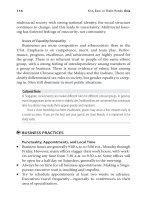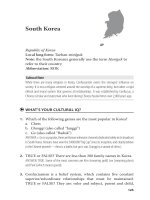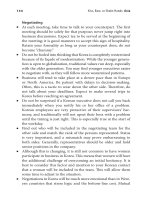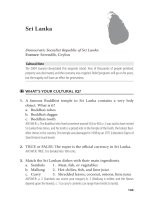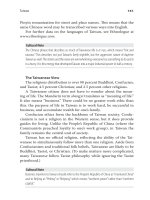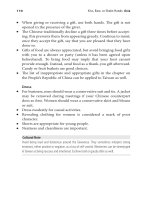How to Do Business in 12 Asian Countries 16
Bạn đang xem bản rút gọn của tài liệu. Xem và tải ngay bản đầy đủ của tài liệu tại đây (101.92 KB, 9 trang )
116
Kiss, Bow, or Shake Hands: Asia
multiracial society with strong national identity, the social structure
continues to change, and this leads to uncertainty. Multiracial hous-
ing has fostered feelings of insecurity, not community.
Issues of Equality/Inequality
Businesses are more competitive and ethnocentric than in the
USA. Emphasis is on competence, merit, and team play. Perfor-
mance, progress, excellence, and achievement are highly prized for
the group. ere is an inherent trust in people of the same ethnic
group, with a strong feeling of interdependency among members of
a group or business. ere is some evidence of ethnic bias among
the dominant Chinese against the Malays and the Indians. ere are
clearly dierentiated sex roles in society, but gender equality is creep-
ing in. Men still dominate in most public situations.
Cultural Note
In Singapore, social events can involve different rules for different cultural groups. In general,
most Singaporeans arrive on time or slightly late. Traditionalists are concerned that arriving on
time to a dinner may make them appear greedy and impatient.
Once a close friendship has been established, guests may arrive a few minutes early to
a social occasion. If you are the host and your guests are close friends, it is important to be
ready early.
●
3
BUSINESS PRACTICES
Punctuality, Appointments, and Local Time
●
Business hours are generally 9:00 .. to 5:00 .., Monday through
Friday. However, many oces stagger their work hours, with work-
ers arriving any time from 7:30 .. to 9:30 .. Some oces will
be open for a half day on Saturdays, generally in the morning.
●
Always be on time for all business appointments. Making a Singa-
porean executive wait is insulting and impolite.
●
Try to schedule appointments at least two weeks in advance.
Executives travel frequently—especially to conferences in their
area of specialization.
●
English is the language of virtually all business or government
correspondence, and most transactions in Singapore. However,
the English spoken oen has native inections, syntax, and gram-
mar, which can easily lead to misunderstandings.
●
Remember that Singapore is a meritocracy. Few people get ahead,
either in business or in government, without hard work and
long hours. Executives will oen work far longer days than their
subordinates.
●
Singaporeans write the day rst, then the month, then the year
(e.g., December 3, 2010, is written 3.12.10 or 3/12/10).
●
For a list of the ocial holidays of Singapore, visit www.kissbowor
shakehands.com.
●
Singapore is eight hours ahead of Greenwich Mean Time (G.M.T.
+ 8), making it thirteen hours ahead of U.S. Eastern Standard
Time (E.S.T. + 13).
Negotiating
●
e pace of business negotiations in Singapore may be slow com-
pared to the West. Be patient.
●
It would be unusual to complete a complicated business deal
in only one trip. Expect to take several trips over a period of
months.
●
Because polite Singaporeans rarely disagree openly, evasion, or
even pretending that a question was never asked, is indicative of a
“no.”
●
Remember that a Singaporean must like and be comfortable with
you personally in order to do business. is relationship does
not extend to your company. If your company replaces you with
another executive, the new person will have to forge this relation-
ship anew (unless the new executive is a blood relative of yours).
●
Unwavering civility is the single most important attribute for suc-
cessful relationships in Singapore. However, diplomacy in no way
hinders the determination of Singaporean businesspeople to get
their own way.
●
People in Singapore may smile or laugh in situations that West-
erners consider inappropriate. Smiles may hide embarrassment,
Singapore
117
118
Kiss, Bow, or Shake Hands: Asia
shyness, bitterness, and/or discord. Singaporean businessmen
may laugh at the most serious part of a business meeting; this
may be an expression of anxiety, not frivolity.
●
In Singapore, a person who loses his or her temper in public is
considered unable to control himself or herself, and will not be
trusted or respected.
●
Be cautious in asking Singaporean Chinese a question. English
speakers would give a negative answer to the question “Isn’t my
order ready yet?” by responding “no” (meaning, “No, it’s not
ready”). e Chinese pattern is the opposite: “yes” (meaning,
“Yes, it is not ready”).
●
Age and seniority are highly respected. If you are part of a delega-
tion, line up so that the most important persons will be introduced
rst. If you are introducing two people, state the name of the most
important person rst (e.g., “President Smith, this is Engineer
Wong”).
●
Speak in quiet, gentle tones. Always remain calm. Leave plenty
of time for someone to respond to a statement you make; people
in Singapore do not jump on the end of someone else’s sentences.
Politeness demands that they leave a respectful pause (as long
as ten to een seconds) before responding. Westerners oen
assume that they have agreement and resume talking before a
Singaporean has a chance to respond.
●
Business cards should be printed (preferably embossed) in English.
Because ethnic Chinese constitute the majority of Singaporeans
(and an even higher percentage of businesspeople), it is a good
idea to have the reverse side of your card translated into Chinese
(gold ink is the most prestigious color for Chinese characters).
●
e exchange of business cards is a formal ceremony. Aer intro-
ductions are made, the visiting businessperson should oer his or
her card. Make sure you give a card to each person present. With
both hands on your card, present it to the recipient with the print
facing him or her, so that he or she can read it. e recipient may
receive the card with both hands, then study it for a few moments
before carefully putting it away in a pocket. You should do the
same when a card is presented to you. Never put a card in your
back pocket, where many men carry their wallets. Do not write
on someone’s business card.
●
Topics to avoid in conversation include any criticism of Singapor-
ean ways, religion, bureaucracy, or politics. Also avoid any discus-
sion of sex.
●
Good topics for discussion include tourism, travel, plans for the
future, organizational success (talking about personal success is
considered impolite boasting), and food (while remaining com-
plimentary to the local cuisine).
Business Entertaining
●
Take advantage of any invitations to social events; successful busi-
ness relationships hinge on strong social relationships.
●
Food is vitally important in Singapore culture. Indeed, the stan-
dard Chinese greeting literally means “Have you eaten?”
●
Respond to written invitations in writing. Among the Chinese,
white and blue are colors associated with sadness; do not print
invitations on paper of these colors. Red or pink paper is a good
choice for invitations.
●
Generally, spouses may be invited to dinners but not to lunch.
However, no business will be discussed at an event where spouses
are present.
●
Singapore’s anticorruption laws are so strict that government o-
cials may be prohibited from attending social events.
Cultural Note
Cleanliness and order is strictly enforced. Trash collection occurs seven days a week and there
are heavy fines for littering. Even the harbor is refuse-free and generally devoid of oil slicks.
●
3
PROTOCOL
Greetings
●
With younger or foreign-educated Singaporeans, a handshake is
the most common form of greeting. e standard Asian hand-
shake is more of a handclasp; it is rather gentle and lasts for
Singapore
119
120
Kiss, Bow, or Shake Hands: Asia
some ten or twelve seconds. (By contrast, most North American
handshakes are very rm but last for only three or four seconds.)
Oen, both hands will be used.
●
Singapore has three major ethnic groups, each with its own tradi-
tions: Chinese, Malay, and Indian.
●
In Singapore, westernized women may shake hands with both
men and women. Singaporean men usually wait for a woman to
oer her hand. It is perfectly acceptable for a woman to simply
nod upon an introduction rather than oer her hand. Women
should oer their hands only upon greetings; too-frequent hand-
shaking is easily misinterpreted as an amorous advance. (Among
themselves, men tend to shake hands on both greeting and
departure.)
●
Among Singaporean Chinese, the traditional greeting was a bow.
However, most now shake hands or combine a bow with a hand-
shake. Chinese men are likely to be comfortable shaking hands
with a woman—more so than other ethnic groups of Singapore.
●
Singaporean Malay are generally Muslim. Traditionally, there is
no physical contact between Muslim men and women. Indeed,
if a religious Muslim male is touched by a woman, he must ritu-
ally cleanse himself before he prays again. Because of this, women
should be careful about oering to shake hands with Malay men,
and men should not oer to shake hands with Malay women. Of
course, if a westernized Malay oers to shake hands, do so.
●
e traditional Malay greeting is the salaam, which is akin to a
handshake without the grip. Both parties stretch out one or both
hands, touch each other’s hand(s) lightly, then bring their hand(s)
back to rest over their heart. is greeting is done only between
people of the same sex. However, if cloth such as a scarf or shawl
prevents actual skin-to-skin contact, then Malay men and women
may engage in the salaam.
●
Many, but not all, Singaporean Indians are Hindu. ey avoid
public contact between men and women, although not as vehe-
mently as most Muslims. Men may shake hands with men, and
women with women, but only westernized Hindus will shake
hands with the opposite sex.



